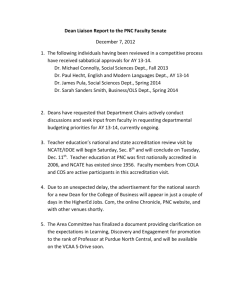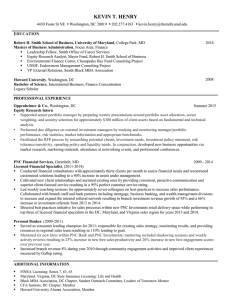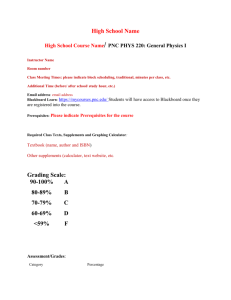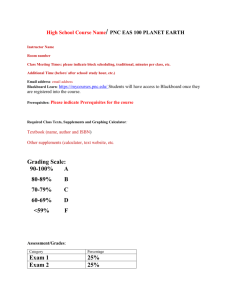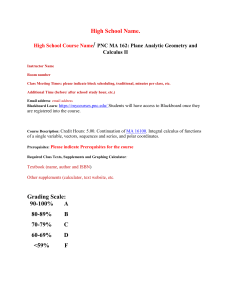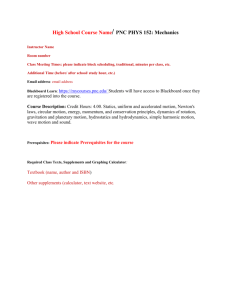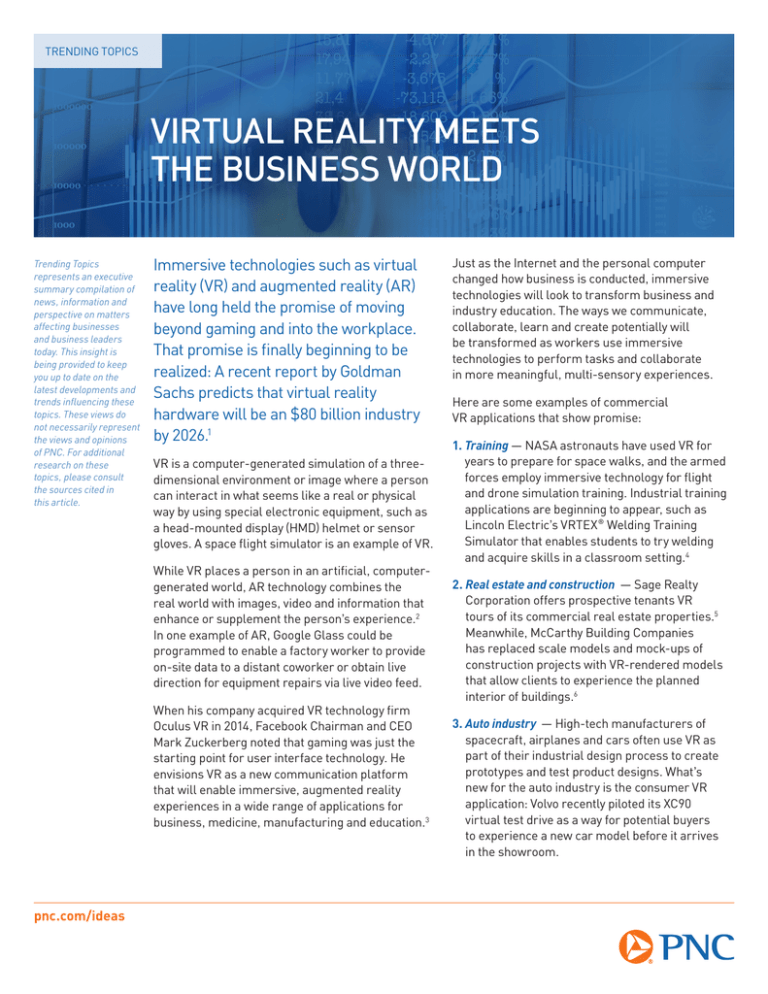
TRENDING TOPICS
VIRTUAL REALITY MEETS
THE BUSINESS WORLD
Trending Topics
represents an executive
summary compilation of
news, information and
perspective on matters
affecting businesses
and business leaders
today. This insight is
being provided to keep
you up to date on the
latest developments and
trends influencing these
topics. These views do
not necessarily represent
the views and opinions
of PNC. For additional
research on these
topics, please consult
the sources cited in
this article.
Immersive technologies such as virtual
reality (VR) and augmented reality (AR)
have long held the promise of moving
beyond gaming and into the workplace.
That promise is finally beginning to be
realized: A recent report by Goldman
Sachs predicts that virtual reality
hardware will be an $80 billion industry
by 2026.1
VR is a computer-generated simulation of a threedimensional environment or image where a person
can interact in what seems like a real or physical
way by using special electronic equipment, such as
a head-mounted display (HMD) helmet or sensor
gloves. A space flight simulator is an example of VR.
While VR places a person in an artificial, computergenerated world, AR technology combines the
real world with images, video and information that
enhance or supplement the person’s experience.2
In one example of AR, Google Glass could be
programmed to enable a factory worker to provide
on-site data to a distant coworker or obtain live
direction for equipment repairs via live video feed.
When his company acquired VR technology firm
Oculus VR in 2014, Facebook Chairman and CEO
Mark Zuckerberg noted that gaming was just the
starting point for user interface technology. He
envisions VR as a new communication platform
that will enable immersive, augmented reality
experiences in a wide range of applications for
business, medicine, manufacturing and education.3
pnc.com/ideas
Just as the Internet and the personal computer
changed how business is conducted, immersive
technologies will look to transform business and
industry education. The ways we communicate,
collaborate, learn and create potentially will
be transformed as workers use immersive
technologies to perform tasks and collaborate
in more meaningful, multi-sensory experiences.
Here are some examples of commercial
VR applications that show promise:
1. Training — NASA astronauts have used VR for
years to prepare for space walks, and the armed
forces employ immersive technology for flight
and drone simulation training. Industrial training
applications are beginning to appear, such as
Lincoln Electric’s VRTEX® Welding Training
Simulator that enables students to try welding
and acquire skills in a classroom setting.4
2. R
eal estate and construction — Sage Realty
Corporation offers prospective tenants VR
tours of its commercial real estate properties.5
Meanwhile, McCarthy Building Companies
has replaced scale models and mock-ups of
construction projects with VR-rendered models
that allow clients to experience the planned
interior of buildings.6
3. Auto industry — High-tech manufacturers of
spacecraft, airplanes and cars often use VR as
part of their industrial design process to create
prototypes and test product designs. What’s
new for the auto industry is the consumer VR
application: Volvo recently piloted its XC90
virtual test drive as a way for potential buyers
to experience a new car model before it arrives
in the showroom.
4. Meetings — From virtual job interviews to board
meetings and global “all hands” events, VR is
already changing how companies define “face
to face” meetings. Interactive technology enables
co-workers to gather in a virtual conference
room and experience the same presentations
simultaneously, engage in shared or private
discussions, and view enhanced 3-D data
visualizations.7
BUSINESS NEEDS DRIVE VR APPLICATIONS
It’s easy to get caught up in the promise of
immersive technologies, but their broader
commercial applications are only in first generation
development. Companies are wise to plan for
iterations and refinements. Brian Blau, personal
technology research director at Gartner, notes that
while VR is exciting in terms of its potential to create
a dramatically new and compelling experience,
VR is simply a tool that should serve as part of a
larger business solution.8
Blau believes companies should focus first on what
business needs may be addressed by immersive
technologies, and then identify which projects and
tasks can be redesigned to take advantage of them.
He recommends undertaking pilot projects first to
allow for proper mapping of tasks and refinements
in user interface, as well as using analytics to
measure and improve results.9
To discuss these topics in more detail, please
contact your PNC Relationship Manager.
1 “The Real Deal with Virtual and Augmented Reality,” a study and video by Heather Bellini of Goldman Sachs, February 2016.
Available at: http://www.goldmansachs.com/our-thinking/pages/virtual-and-augmented-reality.html
2 Definition of augmented reality found at McMillan Dictionary online, available at: http://www.macmillandictionary.com/buzzword/entries/augmented-reality.html
3 Mark Zuckerberg Facebook post announcing Facebook’s acquisition of Oculus VR, March 25, 2014. Available at: https://www.facebook.com/zuck/posts/10101319050523971
4 “Why use VR?” posting on Lincoln Electric web page.
Available at: http://www.lincolnelectric.com/en-us/equipment/training-equipment/Pages/why-use-virtual-reality.aspx
5 “Is virtual reality finally ready for business use?” by John Brandon, CIO.com, Sept. 16, 2015.
Available at: http://www.cio.com/article/2983679/it-industry/is-virtual-reality-finally-ready-for-business-use.html
6 “Is virtual reality finally ready for business use?” by John Brandon, CIO.com, Sept. 16, 2015.
Available at: http://www.cio.com/article/2983679/it-industry/is-virtual-reality-finally-ready-for-business-use.html
7 “6 amazing uses for virtual reality in business,” by John Brandon, Computer World, June 4, 2015.
Available at: http://www.computerworld.com/article/2931551/emerging-technology/6-amazing-uses-for-virtual-reality-in-business.html
8 “Virtual reality and augmented reality in the workplace: A primer for CIOs,” by Erin Carson, Tech Republic, Oct. 7, 2015.
Available at: http://www.techrepublic.com/article/virtual-reality-and-augmented-reality-in-the-workplace-a-primer-for-cios/
9 “Virtual reality and augmented reality in the workplace: A primer for CIOs,” by Erin Carson, Tech Republic, Oct. 7, 2015.
Available at: http://www.techrepublic.com/article/virtual-reality-and-augmented-reality-in-the-workplace-a-primer-for-cios/
PNC is a registered mark of The PNC Financial Services Group, Inc. (“PNC”).
This article was prepared for general information purposes only and is not intended as legal, tax or accounting advice or as recommendations to engage in any specific transaction, and does not purport
to be comprehensive. Under no circumstances should any information contained in this article be used or considered as an offer or commitment, or a solicitation of an offer or commitment, to participate
in any particular transaction or strategy. Any reliance upon any such information is solely and exclusively at your own risk. Please consult your own counsel, accountant or other advisor regarding your
specific situation. Neither PNC Bank nor any other subsidiary of The PNC Financial Services Group, Inc. will be responsible for any consequences of reliance upon any opinion or statement contained here,
or any omission. The opinions expressed in this article are not necessarily the opinions of PNC Bank or any of its affiliates, directors, officers or employees.
©2016 The PNC Financial Services Group, Inc. All rights reserved.
pnc.com/ideas
CIB ENT PDF 0416-090-282201 VR

